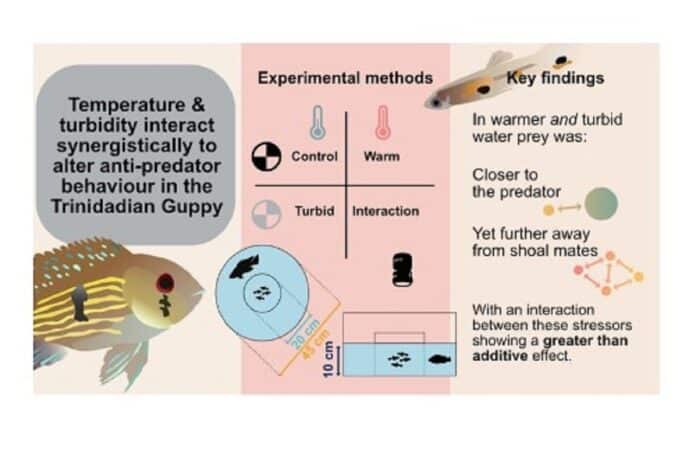A recent study has revealed that warmer and murkier waters create a favorable environment for predators of guppies, a common freshwater fish. The study highlights the impact of environmental conditions on predator-prey dynamics in aquatic ecosystems. By examining the relationship between water temperature, water clarity, and predation risk, the researchers shed light on the factors that influence the survival and abundance of guppies.
The findings provide valuable insights into the complex interactions between species in changing aquatic habitats, with potential implications for understanding and managing freshwater ecosystems.
The study reveals that the combined effects of increased temperature and reduced visibility significantly impact the behavior of guppies, leading them to exhibit reduced predator avoidance and looser protective shoals. The study highlights that the response of guppies to these stressors is more pronounced when they act together rather than independently. With mounting environmental challenges in natural habitats due to human activities such as land use changes, exploitation, and climate change, these findings provide important insights into the complex effects of multiple stressors on aquatic ecosystems.
Costanza Zanghi, the lead author from Bristol’s School of Biological Sciences, at the University of Bristol highlighted the focus of the study on increased temperature and water turbidity, as these factors have been shown to affect visual animals like fish significantly. Warmer water impacts fish swimming ability and hunger levels, while increased turbidity alters visual predators and prey dynamics. The research aimed to understand how visual fish would respond to each other simultaneously when subjected to both stressors. These stressors are becoming more prevalent in freshwater habitats worldwide, making it essential to investigate their combined effects on aquatic ecosystems.
Costanza Zanghi said, “This is important and novel because sometimes, especially when multiple stressors modify similar behaviors in different ways, the overall outcome can be very different from what studies show where only one stressor is tested. That’s because these stressors can interact in unpredictable ways.”
The research team conducted experiments over several weeks involving a predator and a shoal of prey under various conditions to observe their reciprocal responses. Four treatments were created, including optimal housing conditions (control), increased temperature, increased water cloudiness, and a combined treatment of increased temperature and turbidity. The experiments included 36 predators and 288 prey fish, ensuring the safety and well-being of the animals. Video recordings were analyzed to track the fish’s fine-scale movements, calculate swimming speeds, observe the cohesion of the prey shoal, and determine the distance from the predator.
Milly Munro, a co-author, expressed gratitude that temperature and turbidity interacted synergistically to alter anti-predator behavior in the Trinidadian guppy the opportunity and emphasized the valuable skills gained from experience. Lead author Costanza Zanghi highlighted the significance of incorporating multiple stressors in experiments to enhance ecological relevance and practical applications of the study’s findings.
The study’s lead author highlights the importance of investigating how organisms respond to realistic combinations of stressors, as this is more relevant for conservation and management efforts. Understanding how organisms cope with and adapt to multiple stressors can aid in developing effective strategies to mitigate the negative impacts of environmental change.
The research team plans to explore further whether the decrease in anti-predator behavior observed in the study has negative consequences for prey or if it is an adaptive response in a relatively safe environment. They also aim to investigate how these changes may affect different species. The study is significant for introducing ecological complexity to predator-prey interactions and contributing to our understanding of these dynamics in a rapidly changing world.
Journal Reference:
- Costanza Zanghi, Milly Munro et al., Temperature and turbidity interact synergistically to alter anti-predator behavior in the Trinidadian guppy. Proceedings Of The Royal Society B. DOI:10.1098/rspb.2023.0961.
